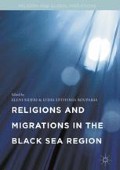Abstract
The way a people narrates major historical events is intimately related to the way it perceives its own identity. Emic coherence is coherence and cohesion in the self-description of a people’s identity, its presentation to the outside world. It encompasses the self-representation of identity in the present and in the past. History is an integral of part of a peoples’ identity. Fereydani Georgians are only a segment of the larger Georgian population of Iran. This chapter deals with the mechanisms by which Fereydani Georgians reaffirm their Shi’ite identity in harmony with the wider and general Iranian Georgians’ role in Iranian history. Furthermore, this chapter will discuss a few alternative and non-hegemonic narratives and representations of Fereydani Georgian identity and history.
Access this chapter
Tax calculation will be finalised at checkout
Purchases are for personal use only
Bibliography
Davrizhetsi, Arakel. [17th century] 2010. Arak’el Dawrizhets’i, Girk’ patmut’eants’ [Arak’el of Tabriz, Book of History]. Introduction and Annotated Translation from Critical Text by George Bournoutian. Costa Mesa, CA: Mazda Publishers.
Dijkink, Gertjan. 1996. National Identity and Geopolitical Visions: Maps of Pride and Pain. London: Routledge.
Friedman, Jonathan. 1992a. The Past in the Future: History and the Politics of Identity. American Anthropologist 94(4): 837–859.
———. 1992b. Myth, History and Political Identity. Cultural Anthropology 7(2): 194–210.
Ghadiani, Abbas. 2005. Tarikh, Farhang va Tamaddon-e Iran dar Dowre-ye Safavi [Iranian History, Culture and Civilization in the Safavid Period]. Tehran: Farhang-e Maktub.
Gorjian-e Iran dar Tarikh [The Georgians of Iran in the Course of History]. http://www.kartvelebi.blogsky.com/
Lockhart, Laurence. 1958. The Fall of the Safavi Dynasty and the Afghan Occupation of Persia. Cambridge: Cambridge University Press.
Moghaddam, Mohammad. 1999. Tuyserkan: Seyr-i dar Owza’-e Tabii, Tarikhi, Eqtesadi va Ejtema’i [Tuyserkan: A Review of the Natural, Historical, Economic and Social Situation]. Tehran: Eqbal.
Monshi, Eskandar Beyg. [17th century] 1998. Tarikh-e Alam-Ara-ye Abbasi (3 vols) [The History of Abbas, the World Adorner]. Edited and commented by Mohammad-Esmail Rezvani. Tehran: Donya-ye Ketab.
Muliani, Said. 2001. Jaygah-e Gorjiha dar Tarikh va Farhang va Tammaddon-e Iran [The Georgians’ Position in Iranian History, Culture and Civilisation]. Esfahan: Yekta.
Panahi Semnani, Ahmad. 1994. Lotf-Ali Khan-e Zand. Tehran: Nashr-e Nemune.
Perry, John. 1979. Karim Khan Zand: A History of Iran, 1747–1779. Chicago, IL: University of Chicago Press.
Pike, Kenneth. 1967. Language in Relation to a Unified Theory of the Structure of Human Behavior. The Hague: Mouton.
Pohl, Jonathan Otto. 2015. Scourging the Caucasus: The Soviet Deportation of the Karachais, Chechens, Ingush, and Balkars in 1943–1944. Forum of EthnoGeoPolitics 3(1): 51–75.
Rahimi, Malek-Mohammad. 2001. Gorjiha-ye Iran: Fereydunshahr [The Georgians of Iran: Fereydunshahr]. Esfahan: Yekta.
Rezvani, Babak. 2008. The Islamization and Ethnogenesis of the Fereydani Georgians. Nationalities Papers 36(4): 593–623.
———. 2009a. The Fereydani Georgian Representation of Identity and Narration of History: A Case of Emic Coherence. Anthropology of the Middle East 4(2): 52–74.
———. 2009b. Iranian Georgians: Prerequisites for a Research. Iran and the Caucasus 13(1): 197–203.
———. 2013. Ethno-Territorial Conflict and Coexistence in the Caucasus, Central Asia and Fereydan. Amsterdam: Vossiuspers, Amsterdam University Press.
———. 2014. Reflections on the Chechen Conflict: Geopolitics, Timing and Transformations. Middle Eastern Studies 50(6): 870–890.
———. 2015. Conflict and Peace in Central Eurasia: Towards Explanations and Understandings. Leiden & Boston, PA: Brill.
Savory, Roger. 1970. Safavid Persia. In Cambridge History of Islam, eds. Peter Malcolm Holt, Ann K. S. Lambton, and Bernard Lewis, vol. 1, 394–429. Cambridge: Cambridge University Press.
Sepiani, Mohammad. 1979. Iraniyan-e Gorji [Georgian Iranians]. Esfahan: Arash.
Sharashenidze, Z. 1979. Phereidneli Gurjebi [Fereydani Gurjis]. Tbilisi: Metsniereba.
Author information
Authors and Affiliations
Editor information
Editors and Affiliations
Rights and permissions
Copyright information
© 2017 The Author(s)
About this chapter
Cite this chapter
Rezvani, B. (2017). Fereydani Georgians: Emic-Coherence, Hegemonic and Non-hegemonic Representation and Narration of Ethnic Identity. In: Sideri, E., Roupakia, L. (eds) Religions and Migrations in the Black Sea Region. Religion and Global Migrations. Palgrave Macmillan, Cham. https://doi.org/10.1007/978-3-319-39067-3_6
Download citation
DOI: https://doi.org/10.1007/978-3-319-39067-3_6
Published:
Publisher Name: Palgrave Macmillan, Cham
Print ISBN: 978-3-319-39066-6
Online ISBN: 978-3-319-39067-3
eBook Packages: Religion and PhilosophyPhilosophy and Religion (R0)

